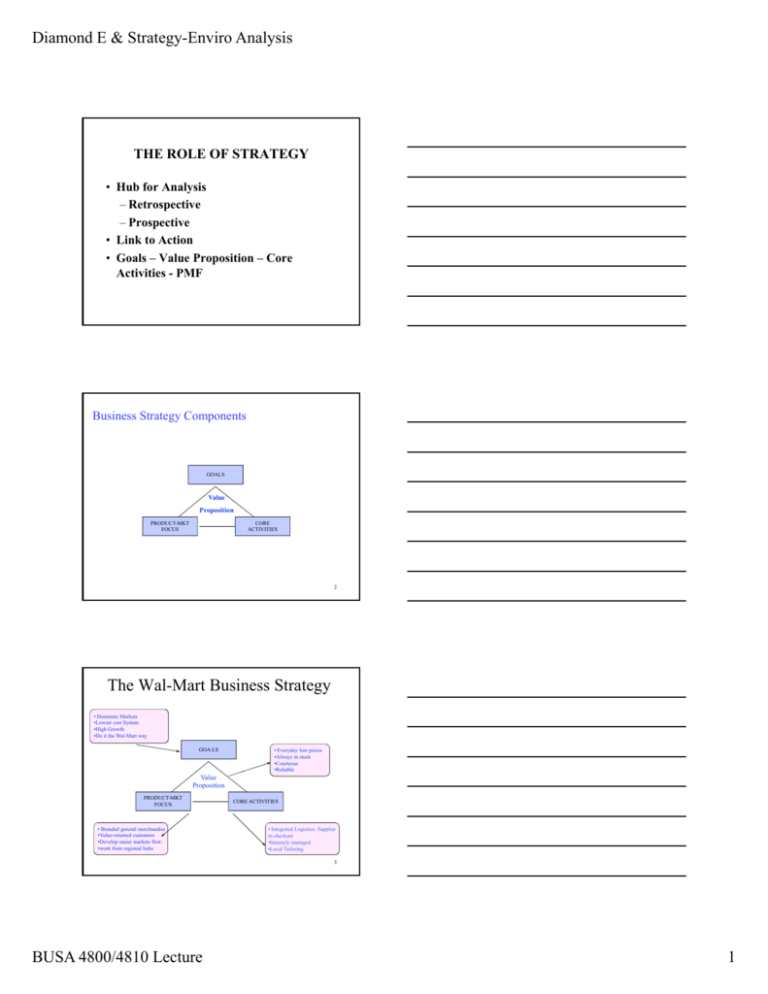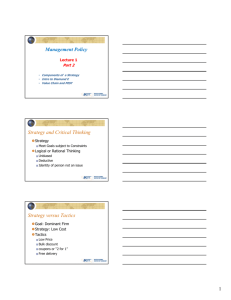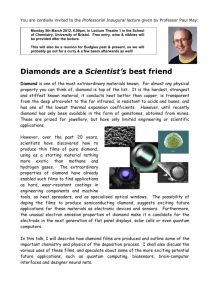Diamond E & Strategy-Enviro Analysis
advertisement

Diamond E & Strategy-Enviro Analysis THE ROLE OF STRATEGY • Hub for Analysis – Retrospective – Prospective • Link to Action • Goals – Value Proposition – Core Activities - PMF Business Strategy Components GOALS V l Value Proposition PRODUCT-MKT FOCUS CORE ACTIVITIES 2 The Wal-Mart Business Strategy • Dominate Markets •Lowest cost System •High Growth •Do it the Wal-Mart way GOA:LS • Everyday low prices •Always in stock •Courteous •Reliable Reliable Value Proposition PRODUCT-MKT FOCUS • Branded general merchandise •Value-oriented customers •Develop easier markets first: •work from regional hubs CORE ACTIVITIES • Integrated Logistics: Supplier to checkout •Intensely managed •Local Tailoring 3 BUSA 4800/4810 Lecture 1 Diamond E & Strategy-Enviro Analysis The Diamond E Framework Management Preferences The ability to Analyze this Is Key Organization Strategy Environment Goals Product/Mkt Competitive Premise Business System Capabilities & Resources 4 Diamond E Framework: Tensions Management Preferences WANT TO DO Organization Strategy CAN DO Environment NEED TO DO Capabilities & Resources Strategic Tension & The Business Model WANT Goals Value Proposition CAN Core Activities BUSA 4800/4810 Lecture Product/ Market NEED 2 Diamond E & Strategy-Enviro Analysis Strategic Risks TIME HORIZON Short-Term RISKS Enviro Capability Long-Term Errors in E i reading di the enviro cause failure Enviro changes g Make the Strategy obsolete Strategic demands Exceed the Capacity to execute Internal cap’y Develop inconsit’y With strategy 7 Strategic Tension WANT Management Preferences Individual Strategic Tension NEED Environment Industry CAN Org’n, Res. & Cap’s Firm The Process of Strategic Analysis Step 1: Base Case Analysis Assess the strategic position of the bus and the urgency for action 1. 2. 3. 4. Step 2: Strategy Formulation and Testing Develop and evaluate proposals to address business opp’y and challenges 1. 2. 3. Step 3: Decision and Implementation 1. Commit, implement, and review 2. 3. BUSA 4800/4810 Lecture Assess past performance Identify and evaluate the current strategy Forecast future performance under current strategy Decide on the need, nature, and speed of change Work from the enviro and capabilities to generate new proposals Use the drill to shape and shortlist proposals Prepare performance forecasts Decide on Proposals to implement Move to build commitment and develop required capabilities Implement 3 Diamond E & Strategy-Enviro Analysis Strategy and Environment Linkage New Strategy Must Fit MANAGEMENT PREFERENCES STRATEGIC CHOICES ORGANIZATION ENVIRONMENT RESOURCES & CAPABILITIES Strategy and Environment Linkage New Strategy Must Fit MANAGEMENT PREFERENCES STRATEGIC CHOICES ORGANIZATION ENVIRONMENT Strategic Choices Repeatedly Reviewed RESOURCES & CAPABILITIES Strategy and Environment Linkage New Strategy Must Fit MANAGEMENT PREFERENCES STRATEGIC CHOICES ORGANIZATION RESOURCES & CAPABILITIES BUSA 4800/4810 Lecture ENVIRONMENT Need to understand Industry economics and competitive environment 4 Diamond E & Strategy-Enviro Analysis Comparison of Focused Enviro Analysis and Macro‐enviro Scanning Key Primary Chara’tics Subjects Output Focused Enviro Analysis •Driven by strategic proposal •Relatively formal •Forecast of performance •Decision to proceed MacroEnviro Scanning •Issue Seeking •Fundamental social, •Continuous informal process economic, and technical trends •Analysis of fit with forces in the defined environment •Identify events of potential impact on the business Cooperation and Competition: Game Theory Few Players ZeroSum Gain NonZero Sum Gain Identifiable Suppress Players Uncertainties •Product •Price Homogeneit leaders y (Price) establish order •High order •Large frequency & inventories small order sizes •Industry Social Structure •Entry Barriers as per Porter SCENARIO PLANNING 1. Define Time & Scope 2. Identify Major Stake Holders 3. Identify Key Identify Key Uncertainties 4. Identify Basic Trends 5. Construct initial Scenario themes BUSA 4800/4810 Lecture 5 Diamond E & Strategy-Enviro Analysis SCENARIO PLANNING 1. Define Time & Scope 2. Identify Major Stake Holders 3. Identify Key Identify Key Uncertainties 4. Identify Basic Trends 5. Construct initial Scenario themes 6. Check for Consistency 7. Develop learning for groups 8 ID further research 8. ID f h h needs 9. Develop Quantitative Models 10. Evolve towards Decision The Process of Environment Analysis Step 1: Focus the Environment Analysis 1. 2. 3. Work from the strategic proposals to define the boundaries Highlight the questions concerning demand, supply, competition, and governmentt Establish a time horizon for analysis The Process of Environment Analysis Step 2: Test the StrategyEnvironment Linkage BUSA 4800/4810 Lecture 1. How well does the strategic proposal anticipate the opp’ys and challenges 2 What is the impact on 2. demand, supply, competition, and government? 3. For serious mis-fit, recycle to develop a more attractive proposal 6 Diamond E & Strategy-Enviro Analysis The Process of Environment Analysis Step 3: Forecast Performance 1. Decide if Proposals will meet its goals 2. With scenario planning see if implementation will ill lead l d to t desired d i d results 3. If fails – recycle to develop more attractive proposals The Process of Environment Analysis Step 4: Rank against other proposals 1. 2. 3. Consider the proposal in light of alternative proposals If it is competitive – proceedd with ith Diamond Di dE Drill If not – consider dropping and recycle to develop a more attractive proposal The Process of Environment Analysis Step 5: Move to the Next 1. Step in the Diamond-E Drill BUSA 4800/4810 Lecture Assess the strategyResource Linkage 7 Diamond E & Strategy-Enviro Analysis The Process of Environment Analysis Step 1: Focus the Environment Analysis Step 2: Test the StrategyEnvironment Linkage GENERATE NEW STRATEGIC PROPOSAL(S) RECYCLE Step 3: Forecast Performance RECYCLE Step 4: Rank Against Other proposals RECYCLE Step 5: Move to Next Step in Diamond-E Drill BUSA 4800/4810 Lecture 8




